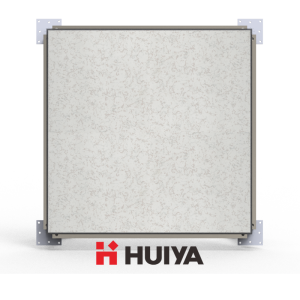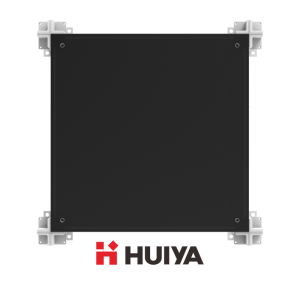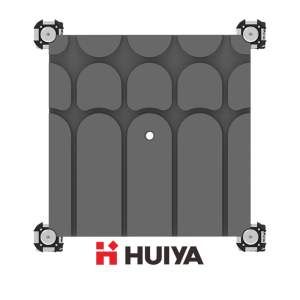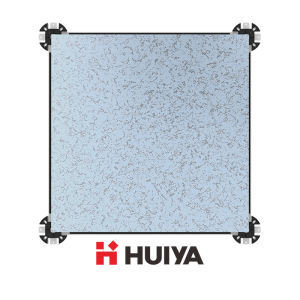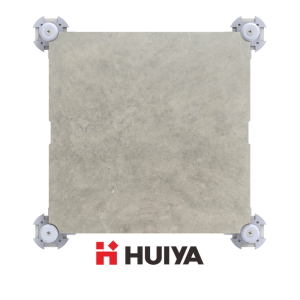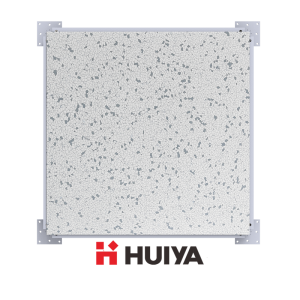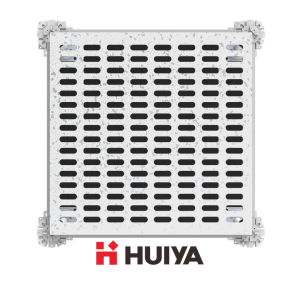Data Center Raised Floor
Showing all 4 results
-
HUIYA.1000LBS.ESD TILE STEEL RAISED FLOOR-DATA CENTER
Data Center Raised Floor -
HUIYA.1000LBS.HPL TILE STEEL RAISED FLOOR-DATA CENTER
Data Center Raised Floor -
HUIYA.1250LBS. PERFORATED STEEL RAISED FLOOR-DATA CENTER
Data Center Raised Floor -
HUIYA.1250LBS.HPL CALCIUM SULPHATE RAISED FLOOR-DATA CENTER
Data Center Raised Floor
Optimize Your Data Center with Huiya Raised Flooring Solutions

At the heart of every high-functioning data centre is the raised floor system, a critical infrastructure component that facilitates optimal airflow, manages cables, and supports heavy equipment. Our Data Center Raised Floor System offers unparalleled efficiency in cooling and managing your computer room environment.
What is a data centre-raised floor, and why is it needed?
A data centre raised floor is an additional floor that is built two inches to four feet above a concrete floor. The objective is to provide an area that enables cooling electrical and mechanical processes. Therefore, in data centres, raised floors are used for distributing cold air. Facilities use raised flooring to reduce the amount of air needed to cool equipment. They require less energy and help enhance temperature distribution across all of the cabinets.
Data centres generate a massive amount of heat as a result of their size, huge working capacity, and long hours of operation. The heat, thus, produced throughout the rows of servers at a data center, can create serious engineering issues. Much of the electricity and energy is consumed in the functioning of these servers, including their maintenance. This is where raised or elevated floors serve their purpose.

Advantages of Using Raised Access Floors in Data Centers & Computer Rooms
Building a raised floor for a data centre can have its advantages. Here’s what makes them beneficial:
- Manages poor airflow capacity Some commercial facilities have poor airflow management. Therefore, introducing additional cooling capacity becomes the next step to combat overheating servers. A raised floor helps reduce the cooling load on thermal behaviour by 40%. It’s physics! Install perforated raised floor tiles within cold aisles. Perforated tiles are installed in hot aisles when a maintenance tile is put in place. Maintenance tiles give employees access to work in a comfortable and warmer environment. Maintenance tiles are not meant for permanent use as they tend to restrict airflow.
- Easier Equipment Upgrades Raised floors enable easy equipment upgrades or the installation of new equipment. For instance, installing large amounts of cable at a data centre proves to be effective and cost-efficient. Raised floors can also help in concealing cables and consolidating ports, and power plugs, and, thus, decluttering the data floor. So, raised flooring at data centers enables effective floor panel planning. In other words, cabling is done on raised floors rather than placing them close to servers, light fixtures, and sprinkler systems.
High-Performance Features for Demanding Environments
A Data Center Raised Floor from HUIYA isn’t just an addition; it’s a necessity for managing the intense heat generated by servers. Huiya Data Center flooring systems are designed with extreme workloads in mind, offering:
- Fire resistance
- High reflectance rates for energy efficiency
- Anti-slip surfaces
- Durability for heavy traffic
- Humidity resistance
- Acoustic dampening
- Improved airflow management, reducing cooling loads by up to 40%
- Easy upgrades and maintenance with efficient cable management
- Aesthetic appeal with various finishes, including anti-static carpeting and High-Pressure Laminate (HPL)
HuiYa Data Center Raised Access Floor Panels & Tiles
There are a few main types of raised floor panels that are commonly used in data centers:
-
- Perforated steel panels – These have rectangular perforations that allow for maximum airflow through the floor. Perforated panels are typically used in hot aisles.

-
- Non-perforated steel panels – Solid steel panels without perforations. Used in areas where airflow isn’t as critical, like cold aisles.

- ESD tiles – Electrostatic discharge-resistant tiles made of materials like steel or calcium sulphate. Help prevent static buildup in sensitive electronic environments.
- Calcium sulphate tiles are made of a cement-based composite material. Provides fire resistance and moisture resistance. Often used for their acoustic-dampening properties.
- HDF/MDF tiles are engineered wood composite tiles. Less durable than steel but provides moisture resistance and acoustic benefits. Usually perforated.
- Tile with hinged access: similar to normal tiles but with a hinged section that can be opened, allowing access to the underfloor space for cable runs or repairs.
Why Install Data Center Raised Flooring from HUIYA?
- Durable, lightweight construction: supports significant loads, up to 6,000 pounds.
- Reduced cooling costs: Improved airflow leads to lower utility and maintenance costs.
- Class “A” flame resistance: A valuable safety feature for your facility.
- Added floor space: Organize cables and avoid trip hazards.
- Design flexibility: Easily reconfigure your setup as needed.
HUIYA Payment and Export Terms
- Condition: New
- Payments: Telegraphic Transfer / Letter of Credit at sight
- Shipping: Sea Freight
- Export: Shipping From China
- Delivery: Estimated 50-250SQM/2 weeks, 500-100000SQM/2 weeks + 1 day for 500 SQM
- Sample: Free (International Delivery Fee Paid by Customer)
- Container Loading: 500SQM/20ft Container
- MOQ: No Quantity Limitation
- Returns: Not accepted
Get Your Quick Quote for Data Center Access Flooring Today
Choose HUIYA for quality products and professional installation. Our Data Center Raised Floor Tiles and Panels are manufactured with precision and quality control, providing the performance and visual appeal that your data centre needs.
With over 20 years of experience in data centre flooring, HUIYA is your trusted partner. Let us help design and install a raised floor system that meets your specific needs. Contact us for a quick quote and take the first step towards an optimized data centre environment.

